Permafrost
| Permafrost | |
|---|---|
 | |
| Map showing extent and types of permafrost in the Northern Hemisphere | |
| Used in: | International Permafrost Association |
| Climate: | High latitudes, alpine regions |
| Wikinews has related news: Scientists warn thawing Siberia may trigger global meltdown |

In geology, permafrost is ground,[1] including rock or (cryotic) soil, at or below the freezing point of water 0 °C (32 °F) for two or more years. Most permafrost is located in high latitudes (in and around the Arctic and Antarctic regions), but alpine permafrost may exist at high altitudes in much lower latitudes. Ground ice is not always present, as may be in the case of nonporous bedrock, but it frequently occurs and it may be in amounts exceeding the potential hydraulic saturation of the ground material. Permafrost accounts for 0.022% of total water on earth[2] and exists in 24% of exposed land in the Northern Hemisphere.[3][4] It also occurs subsea on the continental shelves of the continents surrounding the Arctic Ocean, portions of which were exposed during the last glacial period,[5] with global weather implications.[6]
A global temperature rise of 1.5 °C (2.7 °F) above current levels would be enough to start the thawing of permafrost in Siberia, according to one group of scientists.[4][7]
Extent
.jpg)
Permafrost is soil, rock or sediment that is frozen for more than two consecutive years. In areas not overlain by ice, it exists beneath a layer of soil, rock or sediment, which freezes and thaws annually and is called the "active layer".[8] In practice, this means that permafrost occurs at an average air temperature of -2 °C or colder. Active layer thickness varies with the season, but is 0.3 to 4 meters thick (shallow along the Arctic coast; deep in southern Siberia and the Qinghai-Tibetan Plateau). In the Northern Hemisphere, 24% of the ice-free land area, equivalent to 19 million square kilometers,[9] is more or less influenced by permafrost. Most of this area is found in Siberia, northern Canada, Alaska and Greenland. Beneath the active layer annual temperature swings of permafrost become smaller with depth. The deepest depth of permafrost occurs where geothermal heat maintains a temperature above freezing. Above that bottom limit there may be permafrost, whose temperature doesn't change annually—"isothermal permafrost".[10]
The extent of permafrost varies with the climate. Today, a considerable area of the Arctic is covered by permafrost (including discontinuous permafrost). Overlying permafrost is a thin active layer that seasonally thaws during the summer. Plant life can be supported only within the active layer since growth can occur only in soil that is fully thawed for some part of the year. Thickness of the active layer varies by year and location, but is typically 0.6–4 m (2.0–13.1 ft) thick. In areas of continuous permafrost and harsh winters, the depth of the permafrost can exceed 1,400 m (4,600 ft).[11] Permafrost can also store carbon, both as peat and as methane. Work investigating the permafrost carbon pool size estimates that 1400–1700 Gt of carbon is stored in the northern circumpolar permafrost region.[12] While a recent study that includes stores of the Tibetan Plateau, estimates total carbon pools in the permafrost of the Northern Hemisphere to be 1832 Gt.[13] This large carbon pool represents more carbon than currently exists in all living things.
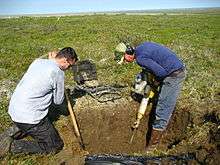
Continuity of coverage
Permafrost typically forms in any climate where the mean annual air temperature is less than the freezing point of water. Exceptions are found in moist-wintered forest climates, such as in Northern Scandinavia and the North-Eastern part of European Russia west of the Urals, where snow acts as an insulating blanket. Glaciated areas may be exceptions. Since all glaciers are warmed at their base by geothermal heat, temperate glaciers, which are near the pressure-melting point throughout, may have liquid water at the interface with the ground and are therefore free of underlying permafrost.[14] "Fossil" cold anomalies in the Geothermal gradient in areas where deep permafrost developed during the Pleistocene persist down to several hundred metres. This is evident from temperature measurements in boreholes in North America and Europe.[15]
Discontinuous permafrost
Typically, the below-ground temperature varies less from season to season than the air temperature, with mean annual temperatures tending to increase with depth. Thus, if the mean annual air temperature is only slightly below 0 °C (32 °F), permafrost will form only in spots that are sheltered—usually with a northerly aspect—creating discontinuous permafrost. Usually, permafrost will remain discontinuous in a climate where the mean annual soil surface temperature is between −5 and 0 °C (23 and 32 °F). In the moist-wintered areas mentioned before, there may not be even discontinuous permafrost down to −2 °C (28 °F). Discontinuous permafrost is often further divided into extensive discontinuous permafrost, where permafrost covers between 50 and 90 percent of the landscape and is usually found in areas with mean annual temperatures between −2 and −4 °C (28 and 25 °F), and sporadic permafrost, where permafrost cover is less than 50 percent of the landscape and typically occurs at mean annual temperatures between 0 and −2 °C (32 and 28 °F).[16] In soil science, the sporadic permafrost zone is abbreviated SPZ and the extensive discontinuous permafrost zone DPZ.[17] Exceptions occur in un-glaciated Siberia and Alaska where the present depth of permafrost is a relic of climatic conditions during glacial ages where winters were up to 11 °C (20 °F) colder than those of today.
Continuous permafrost
| Locality | Area (×1,000) |
|---|---|
| Qinghai-Tibet Plateau | 1,300 km2 (500 sq mi) |
| Khangai-Altai Mountains | 1,000 km2 (390 sq mi) |
| Brooks Range | 263 km2 (102 sq mi) |
| Siberian Mountains | 255 km2 (98 sq mi) |
| Greenland | 251 km2 (97 sq mi) |
| Ural Mountains | 125 km2 (48 sq mi) |
| Andes | 100 km2 (39 sq mi) |
| Rocky Mountains (US and Canada) | 100 km2 (39 sq mi) |
| Fennoscandian mountains | 75 km2 (29 sq mi) |
| Remaining | <100 km2 (39 sq mi) |
At mean annual soil surface temperatures below −5 °C (23 °F) the influence of aspect can never be sufficient to thaw permafrost and a zone of continuous permafrost (abbreviated to CPZ) forms. A line of continuous permafrost in the Northern Hemisphere[19] represents the most southerly border where land is covered by continuous permafrost or glacial ice. The line of continuous permafrost varies around the world northward or southward due to regional climatic changes. In the southern hemisphere, most of the equivalent line would fall within the Southern Ocean if there were land there. Most of the Antarctic continent is overlain by glaciers, under which much of the terrain is subject to basal melting.[20] The exposed land of Antarctica is substantially underlain with permafrost,[21] some of which is subject to warming and thawing along the coastline.[22]
Alpine permafrost
Estimates of the total area of alpine permafrost vary. Bockheim and Munroe[18] combined three sources and made the tabulated estimates by region, totaling 3,560,000 km2 (1,370,000 sq mi).
Alpine permafrost in the Andes has not been mapped.[23] Its extent has been modeled to assess the amount of water bound up in these areas.[24] In 2009, a researcher from Alaska found permafrost at the 4,700 m (15,400 ft) level on Africa's highest peak, Mount Kilimanjaro.[25]
Subsea permafrost
Subsea permafrost occurs beneath the seabed and exists in the continental shelves of the polar regions.[5] These areas formed during the last ice age, when a larger portion of earth's water was bound up in ice sheets on land and when sea levels were low. As the ice sheets melted to again become seawater, the permafrost became submerged shelves under relatively warm and salty boundary conditions, compared to surface permafrost. Therefore, subsea permafrost exists in conditions that lead to its diminishment. According to Osterkamp, subsea permafrost is a factor in the "design, construction, and operation of coastal facilities, structures founded on the seabed, artificial islands, sub-sea pipelines, and wells drilled for exploration and production."[1] It also contains gas hydrates in places, which are both a "potential abundant source of energy", but also may destabilize, as subsea permafrost warms and thaws, producing large amounts of methane gas, which is a potent green-house gas.[1][26]
Manifestations
| Time (yr) | Permafrost depth |
|---|---|
| 1 | 4.44 m (14.6 ft) |
| 350 | 79.9 m (262 ft) |
| 3,500 | 219.3 m (719 ft) |
| 35,000 | 461.4 m (1,514 ft) |
| 100,000 | 567.8 m (1,863 ft) |
| 225,000 | 626.5 m (2,055 ft) |
| 775,000 | 687.7 m (2,256 ft) |
Base depth
Permafrost extends to a base depth where geothermal heat from the earth and the mean annual temperature at the surface achieve an equilibrium temperature of 0 °C.[28] The base depth of permafrost reaches 1,493 m (4,898 ft) in the northern Lena and Yana River basins in Siberia.[11] The geothermal gradient is the rate of increasing temperature with respect to increasing depth in the Earth's interior. Away from tectonic plate boundaries, it is about 25 °C per km of depth (1 °F per 70 feet of depth) near the surface in most of the world.[29] It varies with the thermal conductivity of geologic material and is less for permafrost in soil than in bedrock.[28]
Calculations indicate that the time required to form the deep permafrost underlying Prudhoe Bay, Alaska was over a half-million years.[27][30] This extended over several glacial and interglacial cycles of the Pleistocene and suggests that the present climate of Prudhoe Bay is probably considerably warmer than it has been on average over that period. Such warming over the past 15,000 years is widely accepted.[27] The table to the right shows that the first hundred metres of permafrost forms relatively quickly but that deeper levels take progressively longer.
Massive ground ice
When the ice content of a permafrost exceeds 250 percent (ice to dry soil by mass) it is classified as massive ice. Massive ice bodies can range in composition, in every conceivable gradation from icy mud to pure ice. Massive icy beds have a minimum thickness of at least 2 m, a short diameter of at least 10 m.[31] First recorded North American observations were by European scientists at Canning River, Alaska in 1919.[32] Russian literature provides an earlier date of 1735 and 1739 during the Great North Expedition by P. Lassinius and Kh. P. Laptev, respectively.[33] Two categories of massive ground ice are buried surface ice and intrasedimental ice [34] (also called constitutional ice).[33]
Buried surface ice may derive from snow, frozen lake or sea ice, aufeis (stranded river ice) and—probably the most prevalent—buried glacial ice.[35] Intrasedimental ice forms by in-place freezing of subterranean waters and is dominated by segregational ice which results from the crystallizational differentiation taking place during the freezing of wet sediments, accompanied by water migrating to the freezing front.[33]
Intrasedimental or constitutional ice has been widely observed and studied across Canada and also includes intrusive and injection ice.[32][33]
Additionally, ice wedges—a separate type of ground ice—produce recognizable patterned ground or tundra polygons. Ice wedges form in a pre-existing geological substrate and were first described in 1919.[32][33]
Landforms
Permafrost processes manifest themselves in large-scale land forms, such as palsas and pingos[36] and smaller-scale phenomena, such as patterned ground found in arctic, periglacial and alpine areas.[37]
 A group of palsas, as seen from above, formed by the growth of ice lenses.
A group of palsas, as seen from above, formed by the growth of ice lenses.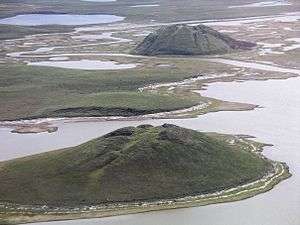
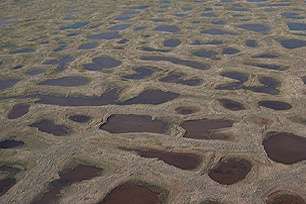
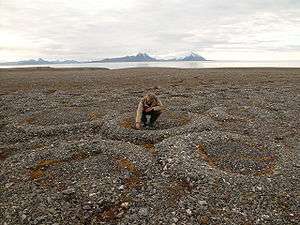
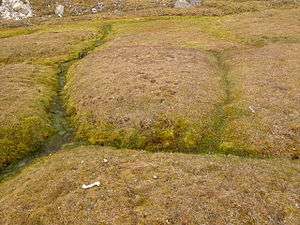 Ice wedges seen from top
Ice wedges seen from top
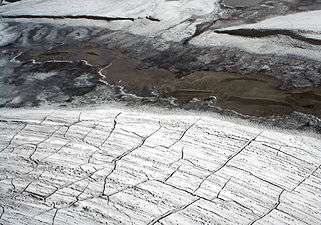 Contraction crack (ice wedge) polygons on Arctic sediment.
Contraction crack (ice wedge) polygons on Arctic sediment.- Cracks forming at the edges of the Storflaket permafrost bog in Sweden.
 Thermokarst lakes near Hudson Bay
Thermokarst lakes near Hudson Bay
Carbon cycle in permafrost
The permafrost carbon cycle (Arctic Carbon Cycle) deals with the transfer of carbon from permafrost soils to terrestrial vegetation and microbes, to the atmosphere, back to vegetation, and finally back to permafrost soils through burial and sedimentation due to cryogenic processes. Some of this carbon is transferred to the ocean and other portions of the globe through the global carbon cycle. The cycle includes the exchange of carbon dioxide and methane between terrestrial components and the atmosphere, as well as the transfer of carbon between land and water as methane, dissolved organic carbon, dissolved inorganic carbon, particulate inorganic carbon and particulate organic carbon.[38]
Climate change effects
Historical changes
At the Last Glacial Maximum, continuous permafrost covered a much greater area than it does today, covering all of ice-free Europe south to about Szeged (southeastern Hungary) and the Sea of Azov (then dry land)[39] and East Asia south to present-day Changchun and Abashiri.[40] In North America, only an extremely narrow belt of permafrost existed south of the ice sheet at about the latitude of New Jersey through southern Iowa and northern Missouri, but permafrost was more extensive in the drier western regions where it extended to the southern border of Idaho and Oregon.[41] In the southern hemisphere, there is some evidence for former permafrost from this period in central Otago and Argentine Patagonia, but was probably discontinuous, and is related to the tundra. Alpine permafrost also occurred in the Drakensberg during glacial maxima above about 3,000 metres (9,840 ft).[42][43]
According to IPCC Fifth Assessment Report there is high confidence that permafrost temperatures have increased in most regions since the early 1980s. Observed warming was up to 3 °C in parts of Northern Alaska (early 1980s to mid-2000s) and up to 2 °C in parts of the Russian European North (1971–2010).[44] In Yukon, the zone of continuous permafrost might have moved 100 kilometres (62 mi) poleward since 1899, but accurate records only go back 30 years. It is thought that permafrost thawing could exacerbate global warming by releasing methane and other hydrocarbons, which are powerful greenhouse gases.[45][46][47] It also could encourage erosion because permafrost lends stability to barren Arctic slopes.
Predicted rate of temperature change in Arctic
Arctic temperatures are expected to increase at roughly twice the global rate.[48] The Intergovernmental Panel on Climate Change (IPCC) will in their fifth report establish scenarios for the future, where the temperature in the Arctic will rise between 1.5 and 2.5 °C by 2040 and with 2 to 7.5 °C by 2100. Estimates vary on how many tons of greenhouse gases are emitted from thawed permafrost soils. One estimate suggests that 110-231 billion tons of CO2 equivalents (about half from carbon dioxide and the other half from methane) will be emitted by 2040, and 850-1400 billion tons by 2100.[49] This corresponds to an average annual emission rate of 4-8 billion tons of CO2 equivalents in the period 2011-2040 and annually 10-16 billion tons of CO2 equivalents in the period 2011-2100 as a result of thawing permafrost. For comparison, the anthropogenic emission of all greenhouse gases in 2010 is approximately 48 billion tons of CO2 equivalents.[50] Release of greenhouse gases from thawed permafrost to the atmosphere may increase global warming.
Thaw

The ground can consist of many substrate materials, including bedrock, sediment, organic matter, water or ice. Frozen ground is that which is below the freezing point of water, whether or not water is present in the substrate. Ground ice is not always present, as may be the case with nonporous bedrock, but it frequently occurs and may be present in amounts exceeding the potential hydraulic saturation of the thawed substrate.
By definition, permafrost is ground that remains frozen for two or more years. Since frozen soil, including permafrost, comprises a large percentage of substrate materials other than ice, it thaws rather than melts even as any ice content melts.[52] An analogy is when a freezer door is left open, although the ice in the freezer may change phase to a liquid, the food solids will not experience a phase change. In aggregate, the food thaws but does not melt. Melting implies the phase change of all solids to liquid. One visible sign of permafrost degradation is the random displacement of trees from their vertical orientation in permafrost areas.[53][54]
As a consequence, precipitation has increased which in turn results in the weakening and eventual collapse of buildings in areas such as Norilsk in northern Russia, which lies upon the permafrost.[55]
Ecological consequences
Worldwide, permafrost contains 1700 billion tons of organic material equaling almost half of all organic material in all soils.[9] This pool was built up over thousands of years and is only slowly degraded under the cold conditions in the Arctic. The amount of carbon sequestered in permafrost is four times the carbon that has been released to the atmosphere due to human activities in modern time.[49] One manifestation of this is yedoma, which is an organic-rich (about 2% carbon by mass) Pleistocene-age loess permafrost with ice content of 50–90% by volume.[56]
Formation of permafrost has significant consequences for ecological systems, primarily due to constraints imposed upon rooting zones, but also due to limitations on den and burrow geometries for fauna requiring subsurface homes. Secondary effects impact species dependent on plants and animals whose habitat is constrained by the permafrost. One of the most widespread examples is the dominance of Black Spruce in extensive permafrost areas, since this species can tolerate rooting pattern constrained to the near surface.[57]
One gram of soil from the active layer may include more than one billion bacteria cells. If placed along each other, bacteria from one kilogram of active layer soil will form a 1000 km long chain. The number of bacteria in permafrost soil varies widely, typically from 1 to 1000 million per gram of soil.[58] Most of these bacteria and fungi in permafrost soil can not be cultured in the laboratory, but the identity of the microorganisms can be revealed by DNA-based techniques.
Should a substantial amount of the carbon enter the atmosphere, it would accelerate planetary warming. A significant proportion will emerge as methane, which is produced when the breakdown occurs in lakes or wetlands. Although it does not remain in the atmosphere for long, methane traps more of the sun’s heat. The Arctic region is one of the many natural sources of the greenhouse gas methane.[59] Global warming accelerates its release, due to both release of methane from existing stores, and from methanogenesis in rotting biomass.[60] Large quantities of methane are stored in the Arctic in natural gas deposits, permafrost, and as submarine clathrates. Permafrost and clathrates degrade on warming, thus large releases of methane from these sources may arise as a result of global warming.[61][62] Other sources of methane include submarine taliks, river transport, ice complex retreat, submarine permafrost and decaying gas hydrate deposits.[63] Preliminary computer analyses suggest that permafrost could produce carbon equal to 15 percent or so of today’s emissions from human activities.[64]
A hypothesis forwarded by Sergey Zimov is that the reduction of herds of large herbivores has increased the ratio of energy emission and energy absorption tundra (energy balance) in a manner that increases the tendency for net thawing of permafrost.[65] He is testing this hypothesis in an experiment at Pleistocene Park, a nature reserve in northeastern Siberia.[66]
Climate change and slope stability
Over the past century, an increasing number of alpine rock slope failure events in mountain ranges around the world have been recorded. It is expected that the high number of structural failures is due to permafrost thawing, which is thought to be linked to climate change. In mountain ranges, much of the structural stability can be attributed to glaciers and permafrost. As climate warms, permafrost thaws, which results in a less stable mountain structure, and ultimately more slope failures.[67]
Other issues
The International Permafrost Association (IPA) is an integrator of issues regarding permafrost. It convenes International Permafrost Conferences, undertakes special projects such as preparing databases, maps, bibliographies, and glossaries, and coordinates international field programmes and networks. Among other issues addressed by the IPA are: Problems for construction on permafrost owing to the change of soil properties of the ground on which structures are placed and the biological processes in permafrost, e.g. the preservation of organisms frozen in situ.
Construction on permafrost
Building on permafrost is difficult because the heat of the building (or pipeline) can thaw the permafrost and destabilize the structure. Three common solutions include: using foundations on wood piles; building on a thick gravel pad (usually 1–2 metres/3.3–6.6 feet thick); or using anhydrous ammonia heat pipes.[68] The Trans-Alaska Pipeline System uses heat pipes built into vertical supports to prevent the pipeline from sinking and the Qingzang railway in Tibet employs a variety of methods to keep the ground cool, both in areas with frost-susceptible soil. Permafrost may necessitate special enclosures for buried utilities, called "utilidors".
The Permafrost Research Institute in Yakutsk, found that the sinking of large buildings into the ground can be prevented by using pile foundations extending down to 15 metres (49 ft) or more. At this depth the temperature does not change with the seasons, remaining at about −5 °C (23 °F).
- Modern buildings in permafrost zones may be built on piles to avoid permafrost-thaw foundation failure from the heat of the building.
.jpg) Heat pipes in vertical supports maintain a frozen bulb around portions of the Trans-Alaska Pipeline that are at risk of thawing.
Heat pipes in vertical supports maintain a frozen bulb around portions of the Trans-Alaska Pipeline that are at risk of thawing.- Above-ground utility lines in a permafrost zone avoid thawing of ground.
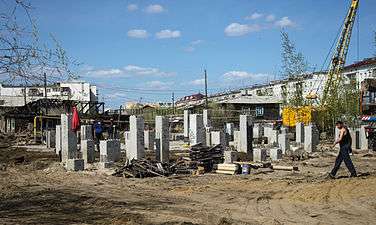 Pile foundations in Yakutsk, a city underlain with continuous permafrost.
Pile foundations in Yakutsk, a city underlain with continuous permafrost.
Revival of organisms preserved in permafrost
In 2012, Russian researchers have proved that permafrost can serve as a natural depository for ancient life forms by the reviving of Silene stenophylla from a tissue as the oldest plant ever to be generated from an Ice Age squirrel burrow in the Siberian permafrost for over 30,000 years. The plant was fertile, producing white flowers and viable seeds. The study demonstrated that tissue can survive ice preservation for tens of thousands of years.[69] A 2016 outbreak of anthrax in the Yamal Peninsula is believed to be due to thawing permafrost.[70]
References
- 1 2 3 Osterkamp, T. E. (2001), "Sub-Sea Permafrost" (PDF), Academic Press: 2902–12, retrieved 2014-11-08
- ↑ Shiklomanov, Igor (1993), "World fresh water resources", in Gleick, Peter H., Water in Crisis: A Guide to the World's Fresh Water Resources, New York: Oxford University Press, retrieved 2014-03-02
- ↑ "Siberian permafrost thaw warning sparked by cave data". BBC News. 22 February 2013. Archived from the original on 23 February 2013. Retrieved 23 February 2013.
- 1 2 Harvey, Fiona (21 February 2013). "1.5C rise in temperature enough to start permafrost melt, scientists warn". The Guardian. Archived from the original on 23 February 2013. Retrieved 23 February 2013.
- 1 2 Editors (2014). "What is Permafrost?". International Permafrost Association. Retrieved 2014-11-08.
- ↑ Margaret Kriz Hobson (December 1, 2016). "Melting Permafrost Could Affect Weather Worldwide; It's not just releasing greenhouse gases—it may also alter the ocean's chemistry and circulation patterns". scientificamerican.com. Scientific American. Retrieved December 2, 2016 – via ClimateWire.
- ↑ Schuur, Ted. "Thawing Permafrost Would Accelerate Global Warming. Thawing Arctic tundra will likely speed up climate change for a century or more. The question is: How drastically?". Scientific American (December 2016): 56–61. Retrieved December 2, 2016.
- ↑ Staff (2014). "What is Permafrost?". International Permafrost Association. Retrieved 2014-02-28.
- 1 2 Tarnocai et al. 2009. Soil organic carbon pools in the northern circumpolar permafrost region. Global Biogeochemical Cycles 23, GB2023
- ↑ Delisle, G. (2007). "Near-surface permafrost degradation: How severe during the 21st century?". Geophysical Research Letters. American Geophysical Union. 34 (L09503): 4. Bibcode:2007GeoRL..34.9503D. doi:10.1029/2007GL029323.
- 1 2 Desonie, Dana (2008). Polar Regions: Human Impacts. New York: Chelsea Press. ISBN 978-0-8160-6218-8.
- ↑ Tarnocai, C.; Canadell, J.G.; Schuur, E.A.G.; Kuhry, P.; Mazhitova, G.; Zimov, S. (June 2009). "Soil organic carbon pools in the northern circumpolar permafrost region" (PDF). Global Biogeochemical Cycles. 23 (2): GB2023. Bibcode:2009GBioC..23.2023T. doi:10.1029/2008GB003327. Archived from the original (PDF) on October 15, 2015.
- ↑ http://www.the-cryosphere.net/9/479/2015/tc-9-479-2015.pdf
- ↑ Sharp, Robert Phillip. Living Ice: Understanding Glaciers and Glaciation. Cambridge University Press. p. 27. ISBN 0-521-33009-2.
- ↑ Majorowicz, Jacek (2012), Permafrost at the ice base of recent pleistocene glaciations – Inferences from borehole temperatures profiles, Physical Geography Series, Bulletin of Geography, doi:10.2478/v10250-012-0001-x
- ↑ Brown, Roger J.E.; Péwé, Troy L. (1973), "Distribution of permafrost in North America and its relationship to the environment: A review, 1963-1973", Permafrost: North American Contribution – Second International Conference, National Academies, 2: 71–100
- ↑ Robinson, S.D.; et al. (2003), "Permafrost and peatland carbon sink capacity with increasing latitude", in Phillips; et al., Permafrost (PDF), Swets & Zeitlinger, pp. 965–970, ISBN 90 5809 582 7, retrieved 2014-03-02
- 1 2 Bockheim, James G.; Munroe, Jeffrey S. (2014), "Organic carbon pools and genesis of alpine soils with permafrost: a review" (PDF), Arctic, Antarctic, and Alpine Research, 46 (4): 987–1006, doi:10.1657/1938-4246-46.4.987, retrieved 2016-04-25
- ↑ Andersland, Orlando B.; Ladanyi, Branko (2004). Frozen ground engineering (2nd ed.). Wiley. p. 5. ISBN 0-471-61549-8.
- ↑ Zoltikov, I.A. (1962), "Heat regime of the central Antarctic glacier", Antarctica, Reports of the Commission, 1961 (in Russian), Publishing House of the Academy of Sciences of the USSR: 27–40
- ↑ Campbell, Iain B.; Claridge, Graeme G. C. (2009), "Antarctic Permafrost Soils", in Margesin, Rosa, Permafrost Soils, 16, Berlin: Springer, pp. 17–31, doi:10.1007/978-3-540-69371-0_2, ISBN 978-3-540-69370-3
- ↑ Heinrich, Holly (July 25, 2013), "Permafrost Melting Faster Than Expected in Antarctica", National Public Radio, retrieved 2016-04-22
- ↑ Azocar, Guillermo (2014), Modeling of Permafrost Distribution in the Semi-arid Chilean Andes, Waterloo, Ontario: University of Waterloo, retrieved 2016-04-23
- ↑ Ruiz, Lucas; Liaudat, Dario Trombotto (2012), Mountain Permafrost Distribution in the Andes of Chubut (Argentina) Based on a Statistical Model (PDF), Tenth International Conference on Permafrost, Mendoza, Argentina: Instituto Argentino de Nivología Glaciología y Ciencias Ambientales, pp. 365–370, retrieved 2016-04-23
- ↑ Rozell, Ned (November 18, 2009), "Permafrost near equator; hummingbirds near subarctic", Capitol City Weekly, Juneau, Alaska, retrieved 2016-04-24
- ↑ IPCC AR4 (2007). "Climate Change 2007: Working Group I: The Physical Science Basis". Retrieved April 12, 2014.
- 1 2 3 Lunardini 1995, p. 35 Table Dl. Freeze at Prudhoe Bay, Alaska.
- 1 2 Osterkamp, T.E.; Burn, C.R., "Permafrost", in North, Gerald R.; Pyle, John A.; Zhang, Fuqing, Encyclopedia of Atmospheric Sciences (PDF), 4, Elsevier, pp. 1717–1729, ISBN 0123822262
- ↑ Fridleifsson,, Ingvar B.; Bertani, Ruggero; Huenges, Ernst; Lund, John W.; Ragnarsson, Arni; Rybach, Ladislaus (2008-02-11). O. Hohmeyer and T. Trittin, ed. "The possible role and contribution of geothermal energy to the mitigation of climate change" (pdf). Luebeck, Germany: 59–80. Retrieved 2013-11-03.
- ↑ Lunardini, Virgil J. (April 1995). "Permafrost Formation Time" (PDF). CRREL Report 95-8. Hanover NH: US Army Corps of Engineers Cold Regions Research and Engineering Laboratory. p. 18. ADA295515.
- ↑ Mackay, J. Ross (1973), "Problems in the origins of massive icy beds, Western Arctic, Canada", Permafrost: North American Contribution – Second International Conference, National Academies, 2: 223–8
- 1 2 3 French, H.M. (2007). The Periglacial Environment (3 ed.). Chichester: Wiley.
- 1 2 3 4 5 Shumskiy, P.A.; Vtyurin, B.I. (1963), "Underground ice", Permafrost International Conference, National Academy of Sciences—National Research Council (1287): 108–13
- ↑ Mackay, J.R.; Dallimore, S.R. (1992), "Massive ice of Tuktoyaktuk area, Western Arctic coast, Canada", Canadian Journal of Earth Sciences, 29: 1234–42
- ↑ Astakhov, 1986; Kaplanskaya and Tarnogradskiy, 1986; Astakhov and Isayeva, 1988; French, 1990; Lacelle et al., 2009
- ↑ Pidwirny, M (2006). "Periglacial Processes and Landforms". Fundamentals of Physical Geography.
- ↑ Kessler MA, Werner BT (January 2003). "Self-organization of sorted patterned ground". Science. 299 (5605): 380–3. doi:10.1126/science.1077309. PMID 12532013.
- ↑ McGuire, A.D., Anderson, L.G., Christensen, T.R., Dallimore, S., Guo, L., Hayes, D.J., Heimann, M., Lorenson, T.D., Macdonald, R.W., and Roulet, N. (2009). "Sensitivity of the carbon cycle in the Arctic to climate change". Ecological Monographs. 79 (4): 523–555. doi:10.1890/08-2025.1.
- ↑ Sidorchuk, Aleksey, Borisova Olga and Panin; Andrey; “Fluvial response to the late Valdai/Holocene environmental change on the East European plain”
- ↑ Yugo Ono and Tomohisa Irino; “Southern migration of westerlies in the Northern Hemisphere PEP II transect during the Last Glacial Maximum” in Quaternary International 118–119 (2004); pp. 13–22
- ↑ Malde, H.E.; “Patterned Ground in the Western Snake River Plain, Idaho, and Its Possible Cold-Climate Origin”; in Geological society of America Bulletin; v. 75 no. 3 (March 1964); pp. 191-208
- ↑ Grab, Stefan; “Characteristics and palaeoenvironmental significance of relict sorted patterned ground, Drakensberg plateau, southern Africa” in Quaternary Science Reviews, vol. 21, issues 14–15, (August 2002), pp. 1729–1744
- ↑ "Inventory of fossil cryogenic forms and structures in Patagonia and the mountains of Argentina beyond the Andes". South African Journal of Science, 98: 171-180, Review Articles, Pretoria, Sudáfrica.
- ↑ Climate Change 2013: The Physical Science Basis Approved Summary for Policymakers IPCC 2013 IPCC Reports
- ↑ Sample, Ian (11 August 2005). "Warming hits 'tipping point'". The Guardian. ]
- ↑ Schuur, E.A.G.; Vogel1, J.G.; Crummer, K.G.; Lee, H.; Sickman J.O.; Osterkamp T.E. (28 May 2009). "The effect of permafrost thaw on old carbon release and net carbon exchange from tundra". Nature. 459 (7246): 556–9. Bibcode:2009Natur.459..556S. doi:10.1038/nature08031.
- ↑ "Thaw point". The Economist. 30 July 2009.
- ↑ IPCC 2007. Summary for policy makers. In: Climate Change 2007: The physical basis. Working group I contribution to the fourth assessment report of the Intergovernmental Panel on Climate Change (eds. Solomon et al.). Cambridge University Press, Cambridge, UK.
- 1 2 Schuur; et al. (2011). "High risk of permafrost thaw". Nature. 480: 32–33. doi:10.1038/480032a.
- ↑ UNEP 2011. Bridging the Emissions Gap. A UNEP Synthesis Report. 56 p. UNEP, Nairobi, Kenya
- ↑ Larry D. Dyke, Wendy E. Sladen (2010). "Permafrost and Peatland Evolution in the Northern Hudson Bay Lowland, Manitoba". doi:10.14430/arctic3332.
- ↑ Grosse, G.; Romanovsky, V.; Nelson, F.E.; Brown, J.; Lewkowicz, A.G. (March 2010). "Why Permafrost Is Thawing, Not Melting" (PDF). Eos, Transactions, American Geophysical Union. 91 (2): 87. Bibcode:2010EOSTr..91...87G. doi:10.1029/2010EO090003.
- ↑ Stevens, William K. (1998-08-18). "Dead Trees and Shriveling Glaciers as Alaska Melts". The New York Times. Retrieved 2007-12-19.
Here and there, roadside utility poles destabilized by the melting tilt at crazy angles. So do trees, creating a phenomenon known as drunken forest.
- ↑ de Villiers, Marq (2001). Water: The Fate of Our Most Precious Resource. Boston: Mariner Books. ISBN 0-618-12744-5.
…caused what the locals call "drunken forests," the trees tilting and leaning…
- ↑ Luhn, Alec (2016-10-14). "Slow-motion wrecks: how thawing permafrost is destroying Arctic cities". The Guardian. ISSN 0261-3077. Retrieved 2016-12-01.
- ↑ Walter KM, Zimov SA, Chanton JP, Verbyla D, Chapin FS (September 2006). "Methane bubbling from Siberian thaw lakes as a positive feedback to climate warming". Nature. 443 (7107): 71–5. doi:10.1038/nature05040. PMID 16957728.
- ↑ C. Michael Hogan, Black Spruce: Picea mariana, GlobalTwitcher.com, ed. Nicklas Stromberg, November, 2008
- ↑ Hansen et al. 2007. Viability, diversity and composition of the bacterial community in a high Arctic permafrost soil from Spitsbergen, Northern Norway, Environmental Microbiology 9, 2870-2884 – and additional references in this paper. Yergeau et al. 2010. The functional potential of high Arctic permafrost revealed by metagenomic sequencing, qPCR and microarray analyses. The ISME Journal 4, 1206-1214
- ↑ Bloom, A. A.; Palmer, P. I.; Fraser, A.; Reay, D. S.; Frankenberg, C. (2010). "Large-Scale Controls of Methanogenesis Inferred from Methane and Gravity Spaceborne Data". Science. 327 (5963): 322–325. Bibcode:2010Sci...327..322B. doi:10.1126/science.1175176. PMID 20075250.
- ↑ Walter, K. M.; Chanton, J. P.; Chapin, F. S.; Schuur, E. A. G.; Zimov, S. A. (2008). "Methane production and bubble emissions from arctic lakes: Isotopic implications for source pathways and ages". Journal of Geophysical Research. 113: G00A08. Bibcode:2008JGRG..11300A08W. doi:10.1029/2007JG000569.
- ↑ Zimov, Sa; Schuur, Ea; Chapin, Fs, 3Rd (Jun 2006). "Climate change. Permafrost and the global carbon budget.". Science. 312 (5780): 1612–3. doi:10.1126/science.1128908. ISSN 0036-8075. PMID 16778046.
- ↑ Shakhova, Natalia (2005). "The distribution of methane on the Siberian Arctic shelves: Implications for the marine methane cycle". Geophysical Research Letters. 32 (9): L09601. Bibcode:2005GeoRL..3209601S. doi:10.1029/2005GL022751.
- ↑ Shakhova, Natalia; Semiletov, Igor (2007). "Methane release and coastal environment in the East Siberian Arctic shelf". Journal of Marine Systems. 66 (1–4): 227–243. Bibcode:2007JMS....66..227S. doi:10.1016/j.jmarsys.2006.06.006.
- ↑ Gillis, Justin (December 16, 2011). "As Permafrost Thaws, Scientists Study the Risks". The New York Times.
- ↑ S.A. Zimov, N.S. Zimov, A.N. Tikhonov, F.S. Chapin III (2012). "Mammoth steppe: a high-productivity phenomenon" (PDF). In: Quaternary Science Reviews, vol. 57, 4 December 2012, p. 42 fig.17. Retrieved 17 October 2014.
- ↑ Sergey A. Zimov (6 May 2005): “Pleistocene Park: Return of the Mammoth's Ecosystem.” In: Science, pages 796–798. Article also to be found in www.pleistocenepark.ru/en/ – Materials. Retrieved 5 May 2013.
- ↑ Huggel, C.; Allen, S.; Deline, P.; et al. (June 2012), "Ice thawing, mountains falling; are alpine rock slope failures increasing?", Geology Today, 28 (3): 98–104, doi:10.1111/j.1365-2451.2012.00836.x
- ↑ Clarke, Edwin S. (2007). Permafrost Foundations—State of the Practice. Monograph Series. American Society of Civil Engineers. ISBN 978-0-7844-0947-3. Retrieved 2014-02-28.
- ↑ Isachenkov, Vladimir (February 20, 2012), "Russians revive Ice Age flower from frozen burrow", Phys.Org, retrieved 2016-04-26
- ↑ "Anthrax Outbreak In Russia Thought To Be Result Of Thawing Permafrost". Retrieved 2016-09-24.
External links
| Wikimedia Commons has media related to Permafrost. |